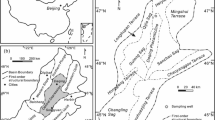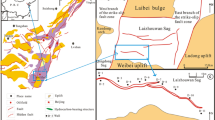Abstract
The chemical characterization of kerogen (typing) is a routine part of petroleum exploration programmes1. Traditionally, kerogen has been characterized on the basis of microscopy2 and bulk chemical methods3, procedures derived from the coal characterization literature1,4. These methods do not today, however, provide adequate resolution of the complex mixture of kerogen components encountered in source rocks from petroleum-bearing sedimentary basins5. Here we report an improved classification approach for kerogens at all maturity levels. The method is based on a quantitative pyrolysis–gas chromatography approach using a polymeric internal standard, polymethylstyrene, to directly determine the absolute concentrations of specific kerogen pyrolysis products. In particular, cross-plots of normal hydrocarbon, aromatic hydrocarbon and total hydrocarbon yields of kerogen pyrolysis are used to recognize eight separate nodes of kerogen composition
This is a preview of subscription content, access via your institution
Access options
Subscribe to this journal
Receive 51 print issues and online access
$199.00 per year
only $3.90 per issue
Buy this article
- Purchase on Springer Link
- Instant access to full article PDF
Prices may be subject to local taxes which are calculated during checkout
Similar content being viewed by others
References
Tissot, B.P. & Weite, D.H. Petroleum Formation and Occurrence (Springer, Berlin, 1978).
Gutjahr, C.C.M. Geologie Mijnb. 62, 417–425 (1983).
Tissot, B.P., Durand, B., Espitalie, J. & Combaz, A. Bull. Am. Ass. Petrol. Geol 58, 499 (1974).
Van Krevelen, D.W. Org. Geochem. 6, 1–10 (1984).
Larter, S.R. in Organic Geochemistry in Exploration of the Norwegian Shelf (ed. Thomas, B. M.) (Norsk. Petrol. Forening Spec. Publ., in the press).
Philp, R.P. & Gilbert, T.D. Org. Geochem. 6, 489–503 (1984).
Larter, S.R., Solli, H., Douglas, A.G., DeLange, F. & DeLeeuw, J.W. Nature 279, 405 (1979).
Van de Meent, D, Brown, S. C., Philp, R. P. & Simoneit, B.R.T. Geochim. cosmochim. Acta 44, 999 (1980).
Van Graas, G., DeLeeuw, J.W. & Schenk, P.A. Geochim. cosmochim. Acta 45, 2465 (1981).
Giraud, A. Bull. Am. Petrol. Geol. 54, 439 (1970).
Larter, S.R. & Douglas, A.G. J. analyt. appl. Pyrolysis 4, 1–19 (1982).
Larter, S.R. in Analytical Pyrolysis-Methods and Applications (ed. Voorhees, K.)212–275 (Butterworths, London, 1984).
Horsfield, B. in Advances in Petroleum Geochemistry Vol. 1 (eds Brooks, J. & Weite, D. H.) 247–298 (Academic, London,1984).
Gormly, J.R. & Mukhopadhyay, P.K. in Advances in Organic Geochemistry 1981 (eds Bjoroy, M. et al.) 597–606 (Wiley, London, 1983).
Bracewell, J.M. & Robertson, G.W. J. analyt. appl. Pyrolysis 6, 19–29 (1984).
Orr, W.L. in Advances in Organic Geochemistry 1981 (eds Bjoroy, M. et al.) 775–788 (Wiley, London, 1983).
Senftle, J-T., Brown, J.H. & Larter, S. R. Int. J. Coal Geol. (in the press).
Author information
Authors and Affiliations
Rights and permissions
About this article
Cite this article
Larter, S., Senftle, J. Improved kerogen typing for petroleum source rock analysis. Nature 318, 277–280 (1985). https://doi.org/10.1038/318277a0
Received:
Accepted:
Issue Date:
DOI: https://doi.org/10.1038/318277a0
This article is cited by
-
Letter to the editors
Naturwissenschaften (1992)
Comments
By submitting a comment you agree to abide by our Terms and Community Guidelines. If you find something abusive or that does not comply with our terms or guidelines please flag it as inappropriate.



